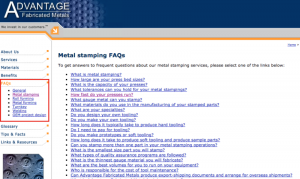Google is about to change the SEO rules again. This time, they’ve made the bold pronouncement that websites that are not friendly to mobile devices will be penalized in search results. This change will have far-reaching implications for everyone with a website, and there are 4 additional twists for PR and marketing communications professionals.
From the Official Google Webmasters Blog:
“Starting April 21, we will be expanding our use of mobile-friendliness as a ranking signal. This change will affect mobile searches in all languages worldwide and will have a significant impact in our search results. Consequently, users will find it easier to get relevant, high quality search results that are optimized for their devices.”
How will this impact your brand? If your site doesn’t conform to Google’s recommended best practices for mobile usability, you will not show up as favorably when someone searches for your brand name or for topics you’re relevant for in search. Here’s an example in current search results; Google notes sites that are mobile-friendly in results [1]:

Contrast that above with sites that are not listed as mobile-friendly [2]; these sites will rank less well after Google’s April 21 deadline.
Some of the basic best practices that Google recommends are:
- Eliminating Flash from your website
- Ensuring you use viewports
- Making fonts big enough to read
- Ensuring clickable/touchable elements are not too close to each other
Google’s free Webmaster Tools software will help to identify those pages on your website that need updating. Want to check out your website easily? Google has released a free Mobile Friendly Testing Tool for finding out how friendly your website is:
If you’re a more sophisticated marketer, be sure to use Webmaster Tools for in-depth analysis.
While these will be tall marching orders for many company websites, there are 3 additional PR-specific complications.
Complication 1: Flash. A fair number of corporate newsrooms attempted in the past to provide a more interactive experience. These newsrooms must now be overhauled to HTML5 in order to remain compliant.
Complication 2: Video. Many companies have preferred to use proprietary video players (based in Flash) rather than upload corporate videos to cloud-based video services like YouTube. Unless your on-site player is HTML5-based, you’ll want to migrate your videos to a compatible platform as quickly as possible. If you’ve got content you would prefer to remain private, consider a platform like Vimeo that provides per-video password protection.
Complication 3: Marketing Automation software. Forms and landing pages on many corporate sites are actually hosted by marketing automation software providers, and those pages may not be compliant with Google’s new guidelines, even if your regular corporate website is. Use Google’s Webmaster Tools service to find those stray pages and update them in addition to the main website.
Complication 4: Podcasts. If you’ve been experimenting with podcasting, know that most podcast players for websites are older, Flash-based players. Upgrade to players from newer providers that are based in HTML5, such as Soundcloud.
Finally, be careful what content you accept for your website! Earned media endorsements like award badges, news clippings, and other copy & paste content are great for providing third party endorsements of you, but be sure the code you’re using doesn’t violate any of Google’s guidelines.
Google’s efforts to force websites into mobile usability compliance are unsurprising. While adhering to the guidelines may cause additional short-term expense, the long term benefits of having a site that functions well on mobile devices is worth the investment.
(260)






